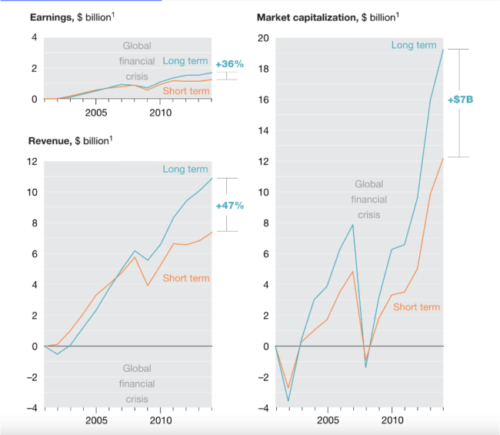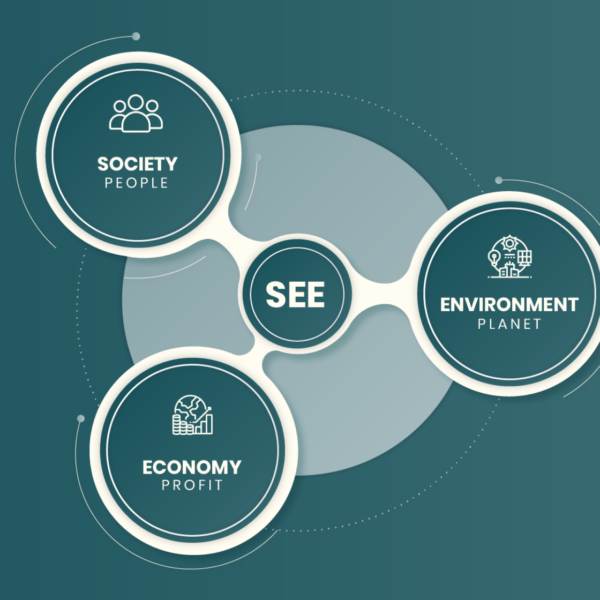Executives are being tasked with not only driving business growth but also providing safe and supportive environments for employees facing mental health challenges and trauma. Read more as Darina Huang discusses what leaders can do to show up and deliver a psychologically safe space for their teams.
Shifting Dynamics in the Private Sector:
A Bigger Reason For Business
Shilpa Gadhok, Founder & CEO
While the term has been popularized for many years, Conscious Capitalism isn’t just a buzz word. Its presence in the private sector is taking a stronger foothold – as it should. There is a need to evolve the greater part of our free-market system toward a model that priorities both profit and civic responsibility. Why? Because: humans. For the majority of the free-market economy’s modern life, we have taken the approach that public and private sectors operate in silos. One carries the economy forward, while the other takes care of solving societal and environmental challenges. Now, that may be an oversimplification as there are companies & brands that do both (i.e. Ben & Jerry’s, Untours, Dr. Bronner’s, Patagonia, just to name a few), but nevertheless the average for-profit company has maintained accountability to a different audience (shareholders) than the public sector (citizens/communities) for decades. But are these two audiences really all that different? After all, aren’t shareholders members of the community too? If at the end of the day we can’t silo our human form, then why do we operate in them? The case for broader collaboration across sectors and an evolution toward a conscious capitalist model (focused on stakeholder primacy) in the private sector is gaining momentum, especially as macro behaviors and dynamics begin to shift.
Choosing to operate under a conscious capitalism philosophy requires business leaders to shift their perspective on how they prioritize and resource innovation, operations, culture, policies, and how they activate against their purpose and values. This can seem like a daunting task – especially for companies and firms who have built over many decades a healthy business model optimizing in favor of their shareholders and from which they have financially benefitted. Where’s the incentive to operate differently? Furthermore, such a move would require long term investment in resources, potential shifts in strategic thinking, and for many, changes to infrastructure and mindsets. However, one thing is clear, those companies and leaders that simply ignore the need to optimize against both profit and purpose will soon find themselves in a very difficult position over the next 10-15 years. Here’s why:
Shifting Dynamics in the For-Profit Sector
Dynamic 1: The Broader Landscape of Society, Environment, and Economy:
When we look at the state of our world today, here’s where we’re at:
Society:
- Pre-Pandemic, 260 million kids were not getting an education, 820 million people were going hungry, and 5.2 million children died every year before the 5th birthday due to mostly preventable infectious diseases. [i]
- In the United States the Household net worth & income gap between white Americans and black Americans has increased by over 90% over the last 20 years. [ii]
- Globally, over 50% of Indigenous adults over the age of 35 have Type 2 Diabetes – in some populations it has reached epidemic proportions. Overall life expectancy for Indigenous populations tends to be up to 20 years less than non-indigenous counterparts.[iii]
- At the current pace of change, according to the UN, it would take up to 257 years to close the gender pay gap. [iv]
Environment:
- In less than 5 decades, populations of mammals, birds, amphibians, and fish have declined by 68% [v]
- We’ve lost nearly half the world’s rainforest[vi] (which contributes significant resources to our global health, food, and environmental ecosystems, in case that needed to be said)
- Our air pollution has contributed to nearly 9 million people prematurely dying worldwide. In 2018, there were 350,000 premature deaths in the United States, and 2.5 Million in India alone[vii]
- Our current food system accounts for 26% of total global greenhouse gas emissions, and 78% of global ocean and freshwater eutrophication (pollution of water ways with nutrient rich water). [viii]
Economy:
- Pre-pandemic roughly half the world population earned less than $5.50/day [ix]
- We are on track to lose nearly one-fifth of global GDP by 2050 due to climate impacts. (China to lose 24% and US to lose 10%) [x]
- Of the roughly 9 Billion world population projected by 2050, an estimated 1 – 3 Billion will become climate refugees when their communities become too hot or too flooded to live in. [xi]
Why should businesses care? Paul Polman, former CEO of Unilever, writes about this very systematically in his book, Net Positive. The broader issues are critical for the private sector to consider because as Polman eloquently puts it: you can’t have a healthy economy with unhealthy people on an unhealthy planet. In order for economies to prosper, it requires a growing number of people to have discretionary income, which is clearly in jeopardy and furthermore, civil unrest is bad for business – and civil unrest comes from growing economic inequality. To sum it up, “businesses cannot thrive in societies that fail.” [xii]
Dynamic 2: Consumer shifts:
But there’s also another dimension and aspect of business that is critical to consider, and that is consumer sentiment and consumer behavior. On a global level, Gen Z accounts for roughly 26% of the population today, which equates to nearly 2 Billion people.[xiii] Combined, Millennials and GenZ account for 49% of the global population today. xiii
Why is this important? Because not only are Millennials the largest workforce in U.S.’s history, but together with Gen Z they are positioned to be on the receiving end of a wealth transfer as big as tens of trillions of dollars in the upcoming years (according to Nasdaq). Which means that their attitudes, their values, their beliefs, their risk tolerance, their purchase behaviors are all critical to future investment strategies and how businesses will need to operate.

A white paper study conducted by First Insight in partnership with University of Pennsylvania Wharton Business School in 2021 showed 75% of Gen Z consumers state sustainability is more important to them than a brand name when making a purchase decision. Furthermore, in a 2021 global study conducted by Edelman, 86% of consumers reported they would like CEO’s to publicly speak out on societal challenges, and 68% of respondents said that businesses needed to step in when government alone didn’t fix societal problems. [xiv] Now, if we consider for a moment that in developing countries, the private sector accounts for 60% of GDP, 80% of capital flows, and 90% of jobs – it clearly has an oversized share of the economy, and therefore, one can reasonably argue, an oversized responsibility to help fix the causes that threaten our ability to have a healthy economic system.[xv] And consumers agree. In a 2021 US Study specifically conducted by Harris Poll, part of a Nielsen, a global market research company, 82% of shoppers said they expected a brand’s values to align with their own and they would vote with their wallet if they didn’t feel the mutual vibe because 75% of consumers reported parting ways with brands over a conflict in values.[xvi] Let’s read that again: Values. Not due to poor quality. Not due to poor customer service. But because of a misalignment in values. Over the last 10 years, and perhaps I’d argue more so in the last 2-3 years, these statistics represent a large shift in the consumer behavior landscape- which is a critical component as companies look to build their strategic plans and goals going forward.
Dynamic 3: Employee Power
Employees are a key stakeholder in this shift as well. In a mere seven years from now, GenZ will account for 30% of the U.S. Labor Force according to the Bureau of Labor Statistics,[xvii] with Millennials making up an additional estimated 40%. That’s nearly 70% of the workforce made up of individuals who are the most ethnically diverse in history, with access to breadth and depth of data, technology, and information surpassing any prior generation, and inheriting a world and ecosystem challenged not only by climate shifts but growing systemic inequity and the enduring consequences. It’s no wonder that in a 2021 survey conducted by Porter Novelli, [xviii] 55% of Gen Z’ers currently employed stated they were reconsidering their jobs because their current employer hadn’t done enough to address social justice issues externally. Values and intention are not enough – this generation is unafraid and unabashedly willing, ready, and able to hold leaders and firms accountable. As the age old saying goes, “actions speak louder than words.”
For companies who have started to turn the tide toward a more socially conscious business, according to 2020 report released by Deloitte Consulting, purpose-driven, socially minded companies reported 40% higher levels of workforce retention vs. their competitors and 30% higher levels of innovation. [xix] Which isn’t insignificant – especially as turnover costs are one of the largest areas of expense for employers.
Dynamic 4: Investors and Financial Markets
It wouldn’t be fair to conclude our assessment of the variables that are driving the shift to a more conscious private sector without looking at the investors and shareholders landscape. The role that investors and shareholders play is pivotal in influencing the private sector to shift behavior or extend its focus. This is where I think it’s important talk a little bit about incentives. Currently, much of the private sector can be dominated by short-term incentives, which leads to short-term thinking, and short-term behavior. As has been noted by many business leaders in previous written work, executives are held to delivering against quarterly reviews, quarterly growth, and short-term ROI’s. As a CEO, or an executive team member, your performance reviews can be tied to these goal posts, your bonuses are tied to them, the valuation of your company is tied to these metrics, and as we all know, the market is not shy in giving you its opinion when you don’t hit your profitability and growth metrics.
In early 2013, McKinsey and the Canada Pension Plan Investment Board (CPPIB) conducted a survey of 1,000 board members and C-suite executives at for-profit companies, and what they found was that while the majority of executives and board members recognized and wanted to conduct business decisions using long-term thinking, they did not and could not due to the pressures to generate short-term financial results.[xx] In fact, 79% surveyed felt especially pressured to demonstrate strong financial performance over a period of just two years or less. So clearly, there is a disconnect between how some C-suite executives want to show up and run their companies, and the way in which they are being incentivized. If you’re incentivized to operate with a short-term view, then all of a sudden, the impacts your business has on societies, communities, the environment, etc…(areas where symptoms take a longer time to develop) is not in your line of sight. It does not make the priority cut. This must change.
In 2014, Dominic Barton and Mark Wisemen wrote in the Harvard Business Review about how “quarterly capitalism” needed to be diminished and a more long-term approach to valuation was critical for investors. They also laid out a 4-step plan of how asset owners could turn data into action in the hopes to help shift how asset and fund managers value companies. In 2016, the non-profit, Focusing Capital on the Long Term, was created to bring together major multinationals (like Cicso, Dow, Tata, Walmart) with major asset-owners and investors like Fidelity, Goldman Sachs, BlackRock) to help educate and inform board owners, asset managers, and investors to focus capital on the long term to support a sustainable economic system.
In 2017 research from McKinsey showed that for those companies operating with a long-term mindset, the average earnings and revenue growth were 36% and 47% higher respectively, with market capitalization rising as well, as compared to firms operating with a short-term mindset.[xxi] While this is encouraging for those leaders wanting to adopt a longer-term strategic plan and incentive structure, more importantly, it accelerates the conversation amongst the investor community on where the scorecard for success needs to shift.

But financial markets are not solely made up of large asset fund managers, they also consist of everyday investors that vote with their wallets on where their investments should go. For example, millennials have played a significant role in the growth of ESG investing. According to Morningstar, they invested $51.1 billion to sustainable funds in 2020 compared with less than $5 billion in 2015. And in 2021, that number went up even higher to $69.2 billion. [xxii] Experts predict that this trend is only set to continue, particularly as more wealth transfers to them. But let’s not forget about GenZ, with 40% saying their investments decisions are driven by “companies with a purpose” as their expected income rises, this boosts the outlook for sustainable investing. [xxiii]
The shift in what the private sector regards as critical to not only its own survival but the survival of our overarching economy and therein, our species has been happening for more than a decade now. However, the acceleration of these focus areas is gaining momentum because for the first time in a long time, all levers that surround the private sector are pointing in a similar direction – whether we look at the state of our world, the growing challenges in underserved communities, we look at the growing momentum of focus from consumers, we look what’s important to employees and where they are putting their power or we look at how governing bodies like the SEC and investor boards are focusing their attention – all levers are pointing toward the need for the private sector to move to a more stakeholder focused model vs. a shareholder focused model. Operating with a stakeholder mindset celebrates the idea that profit and civic responsibility are not at odds with each other, but instead are partners and can amplify the magnitude that each brings to the table.
However, it is important to note that the implementation of this model is a constant work in progress. The lack of broader standardizations and policies exacerbate the difficulty and complexity involved in educating leaders and employees, capturing progress, reporting on progress, and then holding firms accountable to that progress. So yes, there is still much more work to be done – and this is exactly why there is a need to bring together talents across the aisle and sectors to drive innovative solutions and share perspectives to better inform decisions as we build for a new era of business and enterprise.
Sources:
[i] “Learning Poverty,” World Bank, April 2021: https://www.worldbank.org/en/topic/education/brief/what-is-learning-poverty ; World Hunger Is Still Not Going Down after Three Years and Obesity Is Still Growing – UN Report, July 2019. https://www.who.int/news/item/15-07-2019-world-hunger-is-still-not-going-down-after-three-years-and-obesity-is-still-growing-un-report ; “Children: Improving Survival and Well-Being,” World Health Organization (Sept 2020) https://www.who.int/news-room/fact-sheets/detail/children-reducing-mortality.
[ii] Aladangady, Aditya and Forde, Akila (Oct 2021) – “Wealth Inequality and the Racial Wealth Gap”. Published online at FEDS Notes. Retrieved from: https://www.federalreserve.gov/econres/notes/feds-notes/wealth-inequality-and-the-racial-wealth-gap-20211022.html
[iii] United Nations, Department of Economic and Social Affairs, indigenous Peoples. Accessed Dec 11, 2022: https://www.un.org/development/desa/indigenouspeoples/mandated-areas1/health.html
[iv] Closing Gender Pay Gaps Is More Important Than Ever, United Nations, Economic Development (Sept 2022) https://news.un.org/en/story/2022/09/1126901.
[v] Niall, McCarthy, Report: Global Wildlife Populations Have Delcined by 68% in 50 years due to Human Activity, Forbes, accessed Dec 11, 2021
[vi] “Rate of Deforestation,” TheWorldCounts, accessed Dec 11, 2021
[vii] “Fossil Fuel Air Pollution Responsible for 1 in 5 Deaths Worldwide,” Harvard T.H. Chan School of Public Health. Published February 9, 2021.
[viii] Hannah Ritchie and Max Roser (2022) – “Environmental Impacts of Food Production”. Published online at OurWorldInData.org. Retrieved from: ‘https://ourworldindata.org/environmental-impacts-of-food’
[ix] “Nearly Half the World lives on less than $5.50 a Day” World Bank (Oct 2018) , Press Release. https://www.worldbank.org/en/news/press-release/2018/10/17/nearly-half-the-world-lives-on-less-than-550-a-day
[x] “World Economy Set to Lose up to 18% GDP from Climate Change in No Action Taken, Reveals Swiss Re Institute’s Stress –Test Analysis,” Swiss Re (April 2021) https://www.swissre.com/media/press-release/nr-20210422-economics-of-climate-change-risks.html#:~:text=Climate%20change%20poses%20the%20biggest,in%20the%20next%2030%20years.
[xi] Luke Baker, “More than 1 Billion People Face Displacement by 2050 – Report,” Study compiled by Institute for Economics and Peace (IEP) and published by Reuters, September 2020. https://www.reuters.com/article/ecology-global-risks/more-than-1-billion-people-face-displacement-by-2050-report-idUSKBN2600K4
[xii] Polman, Paul, Winston, Andrew, Net Positive: How Courageous Companies Thrive By Giving More Than They Take. Page 17. Harvard Business Review Publishing, 2021.
[xiii] Versace, Chris, Abssy, Mark. “How Millennials and Gen Z are Driving Growth Behind ESG.” Published on Nasdaq. Sept 2022. Accessed online Dec 10, 2022. https://www.nasdaq.com/articles/how-millennials-and-gen-z-are-driving-growth-behind-esg
[xiv] Edelman Trust Barometer 2021. Global Report. Page 35 and 34 respectively.
[xv] Polman, Paul, Winston, Andrew, Net Positive: How Courageous Companies Thrive By Giving More Than They Take. Page 12. Harvard Business Review Publishing, 2021
[xvi] Bounfantino, Giusy. “New Research Shows Consumers Interested In Brands’ Values More Than Ever.” Consumer Goods Technology. April 2022. Accessed online on Dec 10, 2022. https://consumergoods.com/new-research-shows-consumers-more-interested-brands-values-ever
[xvii] Freehling, Emily. “To Win The Talent Race, It’s Time To Get To Know Gen Z,” The Darden Report. Published by University of Virginia Darden School of Business. Aug 2022. Accessed online Dec 10, 2022. https://news.darden.virginia.edu/2022/08/10/its-time-to-get-to-know-gen-z/#:~:text=The%20U.S.%20Bureau%20of%20Labor,environment%20dictated%20by%20pandemic%20limitations.
[xviii] Freehling, Emily. “To Win The Talent Race, It’s Time To Get To Know Gen Z,” The Darden Report. Published by University of Virginia Darden School of Business. Aug 2022. Accessed online Dec 10, 2022. https://news.darden.virginia.edu/2022/08/10/its-time-to-get-to-know-gen-z/#:~:text=The%20U.S.%20Bureau%20of%20Labor,environment%20dictated%20by%20pandemic%20limitations.
[xix] Purpose is everything: How Brands That Authentically Lead With Purpose Are Changing The Nature of Business Today. Deloitte Insights. Oct 2019. Accessed online on Dec 10, 2022. https://www2.deloitte.com/us/en/insights/topics/marketing-and-sales-operations/global-marketing-trends/2020/purpose-driven-companies.html
[xx] Barton, Dominic, Wiseman, Mark. “Focusing Capital On the Long-Term.” Harvard Business Review Magazine. Feb 2014. Accessed Dec 16, 2022. https://hbr.org/2014/01/focusing-capital-on-the-long-term
[xxi] “Where Companies with a Long-Term View Outperform Their Peers,” Feb 8, 2017. Corporate Performance Analytics by McKinsey, S&P Capital IQ, McKinsey Global Institute Analysis. https://www.mckinsey.com/featured-insights/long-term-capitalism/where-companies-with-a-long-term-view-outperform-their-peers; Polman, Paul, Winston, Andrew, Net Positive: How Courageous Companies Thrive By Giving More Than They Take. Page 33-34. Harvard Business Review Publishing, 2021
[xxii] Versace, Chris, Abssy, Mark. “How Millennials and Gen Z are Driving Growth Behind ESG.” Published on Nasdaq. Sept 2022. Accessed online Dec 10, 2022. https://www.nasdaq.com/articles/how-millennials-and-gen-z-are-driving-growth-behind-esg
[xxiii] Versace, Chris, Abssy, Mark. “How Millennials and Gen Z are Driving Growth Behind ESG.” Published on Nasdaq. Sept 2022. Accessed online Dec 10, 2022. https://www.nasdaq.com/articles/how-millennials-and-gen-z-are-driving-growth-behind-esg
A Future That Is Not Only Good – But Green
They say “you are what you eat”... but what happens to what you don’t eat? Find out as Asjia Chapin explores how hospitality professionals and business leaders alike can help turn food waste into better for business and the environment.
Top 5 Takeaways from the TED Countdown Summit on Climate Action 2023
On July 11, 2023 over 850 business executives, political leaders, artists, activists, youth leaders, and educators came together to collaborate at the 2023 TED Countdown Summit on climate action. Here are my Top 5 takeaways.
Why Food Education Should Be on the Menu in U.S. Schools
Incorporating lessons about food and agriculture as it relates to personal nutrition, social constructs, equality and connection, and the environment is imperative as we build the future leaders of our globalized society. See how national non-profit Pilot Light is working to educate our food change-makers of tomorrow.
A Brand Builder’s Anti-Greenwashing Guide
Greenwashing should never be the intention, but sometimes even well-intentioned Brand Builders and Marketing Teams can fall into this trap. Check out my Top 5 tips that will save you and your teams from greenwashing and help you be proactive with communicating your brand's impact in an honest way.
Shifting Dynamics in the Private Sector: A Bigger Reason For Business
There is an evolution underway in the private sector - one that will require CEOs and executives to shift the way they operate and how they prioritize resources. In this article, we explore the shifting dynamics fueling the movement toward Conscious Capitalism.

Empowering Change.
Disclaimers

Empowering Change.
© 2023 SEE GOOD STRATEGY GROUP .






